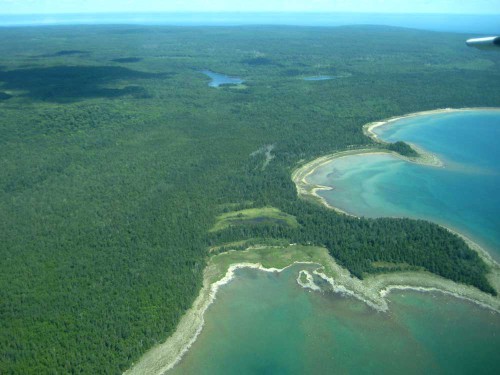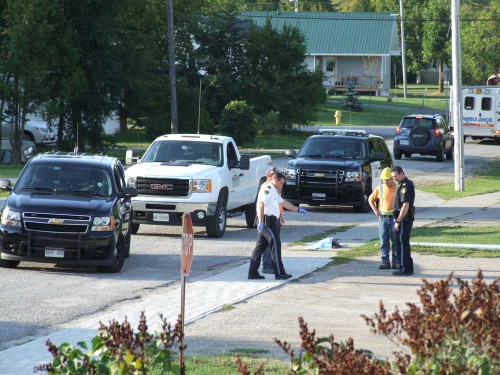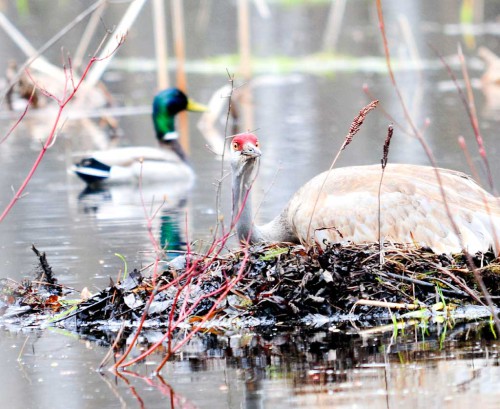COCKBURN ISLAND––The Nature Conservancy of Canada (NCC) is hoping to seal the deal on a $15.2 million project that includes an offer to purchase 24,000 acres (9,712 hectacres) of near-pristine forest property on Cockburn Island from the Huron Timber Company of Coldwater, Michigan. The land included in the sale comprises some 80 percent of the land base in one of Canada’s smallest and oldest municipalities.
According to a press release from the NCC, property features include over 45 kilometres of undeveloped shoreline, high quality sand dunes, cobble beaches, and coastal wetlands. Inland areas also contain a vast sand plain forest, a cranberry bog, and alvars—a rare habitat found on limestone bedrock such as that which covers much of western Manitoulin in areas that feature little to no soil cover.
If the project is successful, the purchase will create Ontario’s largest protected hardwood forest south of the Canadian Shield and the single largest (in size) conservation project in the province. Two thirds of the cost of the project has been raised.
“The Cockburn Island project will conserve one tree for every Ontarian,” said James Duncan, NCC Regional Vice President for Ontario in the release. “The window of opportunity to conserve this large a project in southern Ontario is open now. If NCC cannot mobilize the resources to conserve this beautiful piece of Canada, it will likely be carved up, sold off, and developed. Every dollar counts: if just half of Ontarians gave $1 each we would have the remaining $5 million needed for this project.”
Municipality of Cockburn Island Mayor David Haight is greeting the proposed sale with more curiosity than alarm.
“We don’t really know much more than what we have read in the media about the deal,” said Mayor Haight. “We are trying to get a meeting together with the Nature Conservancy to find out more of the details.”
Mayor Haight noted that the council would prefer to deal with facts as opposed to rumour. “There are all kinds of stories going around,” he said. “But right now I don’t think anybody really knows that much about what this means to the community.”
The Nature Conservancy has announced that it has secured a $5 million donation from an anonymous American donor and that they have until December to come up with another $5 million to make the deal work.
“The total value of the project, including purchase of the land and other associated costs, and including setting up a stewardship endowment to allow for the ongoing maintenance of the property, is $15.2 million,” said Nature Conservancy of Canada Midwest project manager John Grant. The Globe and Mail had reported the land deal itself at that amount, but Mr. Grant told The Expositor it was important to realize that the entire project cost is included in that total.
The NCC has scheduled an October 11 meeting with the municipal council to go over the details of the deal and its potential impacts on the municipality. Mr. Grant noted that he has had a number of conversations with Mr. Haight on the project, but that many of the details are still in flux.
“We understand the council’s concerns,” said Mr. Grant, noting that there are myriad expenses attached to maintaining even a community that is largely seasonal. “There are a lot of facts to consider, but we are looking for a win-win situation.”
The NCC, said Mr. Grant, hopes that as time passes Manitoulin Islanders will come to see the NCC as having an overall positive impact on their communities.
One of the key reasons that the Cockburn Island council does not have many answers to its questions yet is that a lot of the details have yet to be determined.
“I think a lot of the questions to which people don’t yet have answers is because we will be taking community input into the decisions,” said Mr. Grant. “A lot of those answers will come after that input.”
The seller, the Huron Timber Company, a privately held corporation owned by members of the family of the late Lonnie Avra, a respected Coldwater businessman who died in a 2008 plane crash, is reported to be retaining some 10,000-11,000 acres of timber land for potential logging.
The NCC press release notes that much of Cockburn Island was logged or cleared for agriculture in the late 1800s, but when the ferry service to the island, which lies about three kilometres from Manitoulin’s westernmost tip, ceased, its isolation resulted in the abandonment of the farmsteads. Today the island’s population of cottagers is seasonal, mostly clustered in houses in the old village of Tolsmaville, leaving the natural habitats on the island largely untouched and in very good condition.
The only year-round inhabitant of the community is a caretaker hired by the municipality. “It has been hard to get on and off the island in the winter,” noted Mayor Haight. “Last year there wasn’t any snow and there was no ice cover,” making wintertime travel to the site by snowmachine problematic.
As for the island’s other large landholders, Mr. Grant said that he has not yet had the opportunity to speak with Chief Irene Kells of the Zhiibaahaasing First Nation, which also has land on the island. “I spoke with one of the councillors there, but the chief was not yet available,” said Mr. Grant. “I called the band to let them know about the sale as a courtesy before the press release went out.”
Laura Mousseau, NCC national media relations manager, noted that while the goal of raising $5 million may seem daunting and out of reach of the average conservation-minded donor, donations of $5, $10 or $20 can quickly add up.
“Every dollar counts,” agreed Mr. Grant, adding that, “the clock is ticking.”
The NCC has until December to raise the remaining $5 million to make the project work, and this project provides a rare opportunity to become part of Ontario conservation history.
At 45 kilometres, the shoreline that will be protected is longer than an Olympic marathon, according to the press release. In fact, it would take an average person over nine hours to walk that distance even on a smooth sidewalk.
The area to be protected is equal to 12,000 Canadian Football League playing fields and could contain some 1,890 complete Toronto Skydomes. That stacks up considerably against the current one percent of Cockburn Island that is currently protected.
Cockburn Island was assessed in the 2010 ‘Islands of Life’ study of Great Lakes islands, ranking as the tenth highest in conservation priority out of 2,003 assessed sites; there are 32,000 islands in the Great Lakes.
The Cockburn Island project will protect an area that includes four separate watersheds and approximately 13 million combined mature trees, seedlings and saplings. As the NCC pointed out, that is one for every resident of Ontario.
By its very nature, said the NCC, the island is isolated and sensitive to change and it provides safe haven for uncommon habitats and a wealth and variety of native species, many rare.
Cockburn Island is also a critical stopover point for migratory birds that rest and feed on its shores during annual spring and fall migrations. It is also the seventh-largest island in the Great Lakes.





